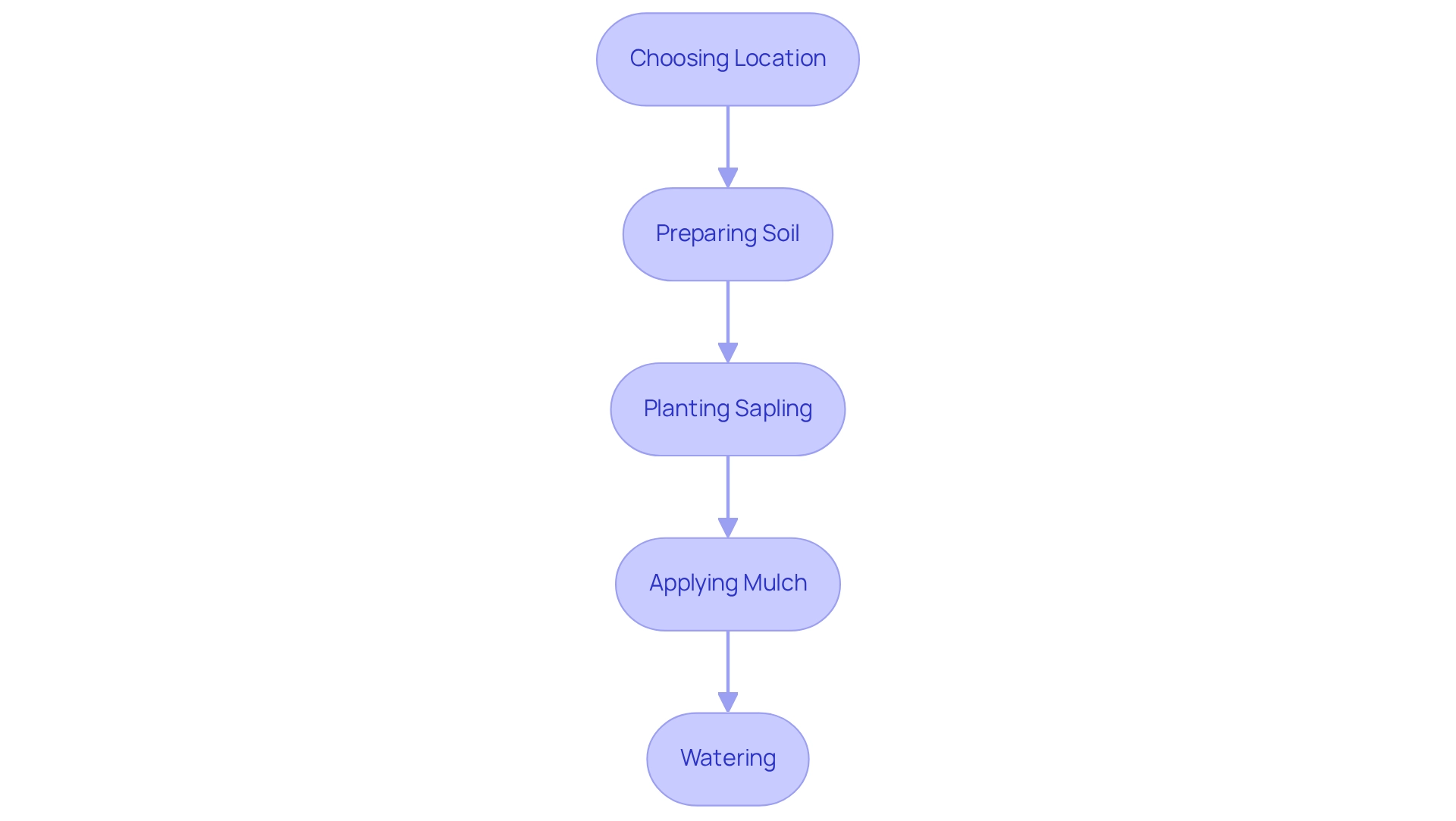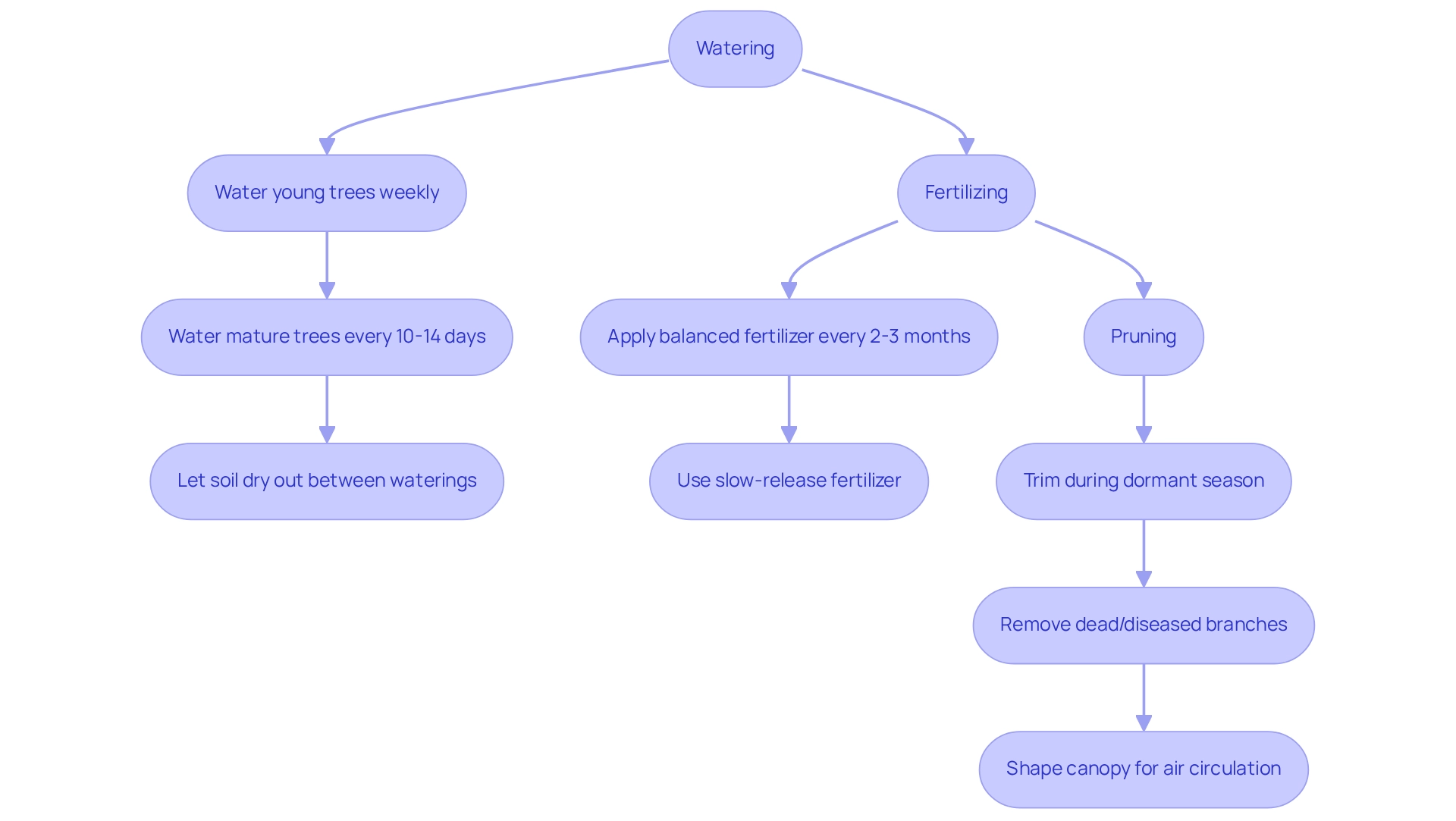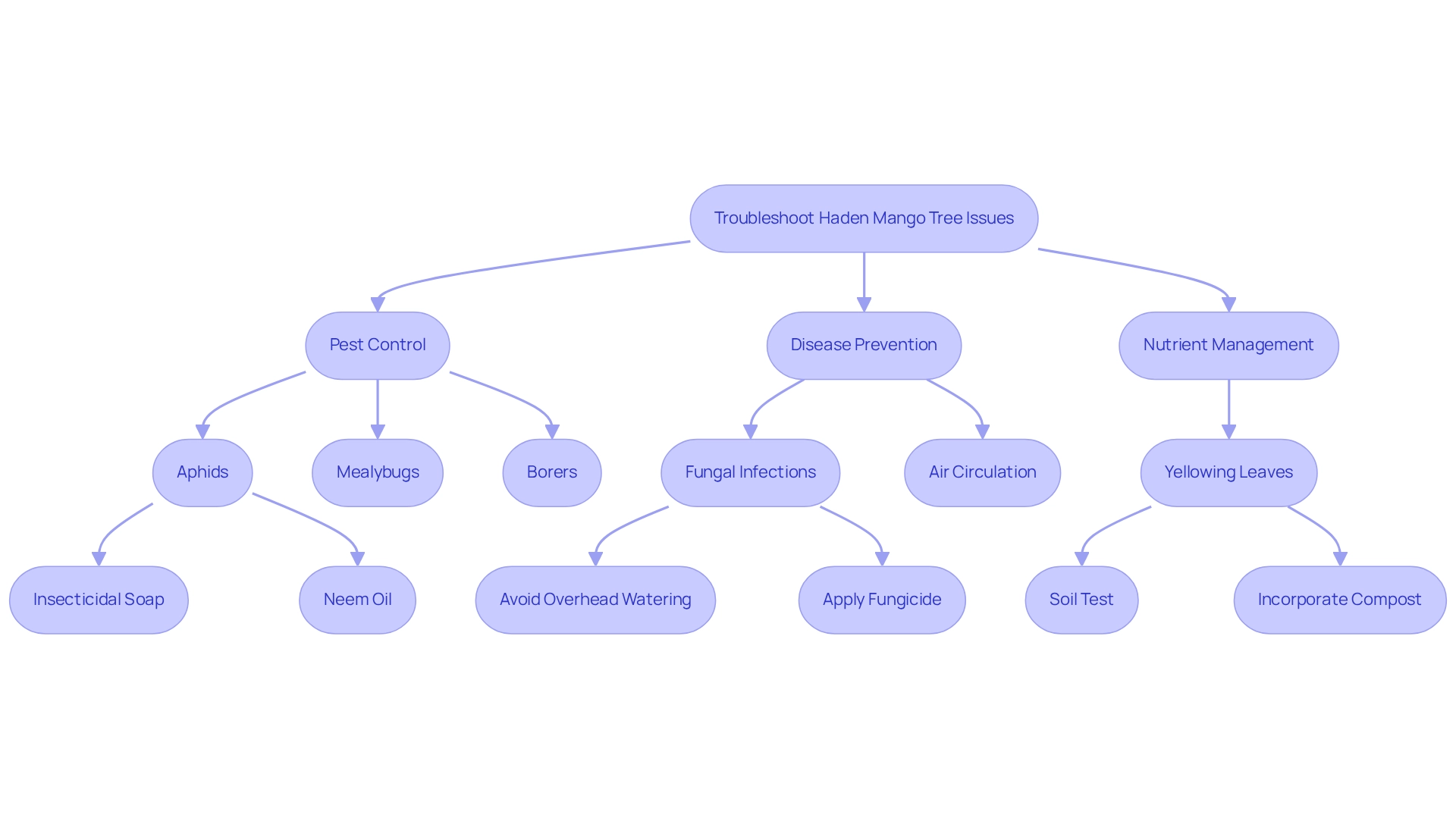
Step-by-Step Guide to Growing a Haden Mango Tree
Share
This article offers a nurturing step-by-step guide to successfully growing a Haden mango tree. It emphasizes the importance of creating the right growing conditions, mastering planting techniques, and committing to ongoing maintenance. We understand that gardening can be challenging, so we outline essential factors such as ideal climate, soil requirements, watering schedules, and pest control measures. By adhering to these practices, you can significantly enhance the health and productivity of your mango tree.
Imagine the joy of watching your Haden mango tree thrive! With the right care, you can create a flourishing environment that supports its growth. Remember, every gardener faces hurdles; it’s all part of the journey. As you implement these tips, you’ll find that nurturing your mango tree becomes a rewarding experience.
Let’s explore the key elements together:
- Ideal Climate: Ensure your tree gets plenty of sunlight.
- Soil Requirements: Use well-draining soil rich in organic matter.
- Watering Schedule: Regular watering is crucial, especially during dry spells.
- Pest Control Measures: Stay vigilant against pests to protect your tree.
By focusing on these areas, you can cultivate a healthy mango tree that brings you joy and delicious fruit. Remember, you are not alone in this journey; we’re here to support you every step of the way. Let’s nurture your passion for gardening and watch your Haden mango tree flourish!
🌴 Want to grow a sweet, tropical mango tree at home?
You’re not alone! The Haden Mango Tree is one of the most popular varieties, known for its large, juicy fruits and beautiful canopy. In this guide, you’ll learn how to plant, care for, and troubleshoot your Haden mango tree step by step.
👉 Shop the Haden Mango Tree (Grafted) — shipped directly from Florida with expert care.

The allure of Haden mango trees captivates not just because of their vibrant fruit but also due to the specific growing conditions that nurture their success. These trees thrive in warm climates and require ample sunlight, demanding your careful attention to detail in their cultivation. Have you ever wondered about the best location for planting or the right balance of watering and fertilizing? Navigating these factors is essential for ensuring a fruitful harvest.
This guide is here to support you through common challenges and offer effective solutions. Together, we can explore a comprehensive roadmap for nurturing Haden mango trees, empowering you to cultivate these tropical delights with confidence. Embrace the journey of gardening, knowing that every step you take brings you closer to enjoying the sweet rewards of your labor.
1. Understand the Growing Conditions for Haden Mango Trees
Haden mango trees flourish beautifully in USDA Zones 9 to 11, thriving in warm climates where temperatures range from 80°F to 100°F. These beloved plants crave complete sun exposure, ideally basking in 8 to 10 hours of direct sunlight each day to promote optimal growth and fruit production. To support their needs, well-draining sandy loam soil with a pH level between 5.5 and 7.5 is preferred, allowing roots to access essential nutrients without the risk of waterlogging.
When choosing a planting location, it's vital to protect these delicate plants from strong winds while ensuring good air circulation. This helps prevent fungal diseases that could threaten their health. Moreover, since certain fruit-bearing plants are sensitive to frost, selecting a site that avoids cold drafts is crucial for their survival and productivity. By adhering to these growing conditions, gardeners can enjoy successful cultivation of the Haden mango tree and other specific fruit trees in USDA Zones 9 to 11, leading to a bountiful harvest.
It's heartening to note that 77% of reviews for the Mango Tree are positive, reflecting its desirability among fellow gardeners. As Jillian Balli wisely shares, "The fruits can be stored in the fridge or they can be frozen, dehydrated, and canned," offering practical advice for post-harvest handling. Typically, these delightful fruits are harvested in June or July, making it essential for gardeners to prepare thoughtfully.
For more insights into the Haden mango tree and other fruit-bearing varieties, explore our Fast-Growing Plants collection on our website. We are committed to eco-friendly practices and high-quality fertilizers, ensuring you have the best support on your gardening journey.

2. Plant Your Haden Mango Tree: Step-by-Step Instructions
-
Choosing the right location for your Haden mango tree is crucial. Look for a location that basks in full sun for at least six hours a day and boasts well-draining soil. It's important to avoid areas prone to stagnant water, as these resilient plants thrive in drier conditions. Remember, these magnificent trees can reach impressive heights of up to 30 feet, so ensure you have plenty of space for them to flourish.
-
Prepare the Soil: When you're ready to plant your Haden mango tree, dig a hole that is twice as wide and deep as the root ball. Enrich the soil by mixing in compost, which will provide essential nutrients and improve drainage. It's fascinating to note that proper planting density can significantly enhance orchard yield, so consider this as you prepare your planting area.
-
Plant the Sapling: Gently place the sapling in the center of the hole, ensuring that the top of the root ball is level with the surrounding earth. As you refill the hole, take care to hydrate the area thoroughly, removing any air pockets that could hinder root development. This nurturing step is vital for your tree’s growth.
-
Mulch: A layer of organic mulch around the base of your plant will work wonders. This simple addition helps retain moisture, suppresses weeds, and regulates soil temperature, creating a nurturing environment for your tree to thrive.
- Watering: After planting, give your new friend a deep drink of water. In the initial weeks, keep the soil consistently moist, but be mindful not to overwater, as these plants prefer slightly dry conditions once they're established. Paying close attention to watering during these early stages is essential; it enhances the quality and longevity of your plant, echoing best practices found in post-harvest management studies. Remember, you’re not just planting a tree; you’re nurturing a future bounty.

3. Maintain Your Haden Mango Tree: Watering, Fertilizing, and Pruning
-
Watering: If you're nurturing young Haden mango tree plants, you'll find that Haden mango trees truly thrive with consistent moisture. Aim to irrigate them about once a week. As your Haden mango tree matures, it will appreciate a less frequent watering schedule, needing water every 10 to 14 days. Remember, it’s important to let the soil dry out a bit between waterings to prevent root decay, which can be detrimental to their health. As Jonathan H. Crane wisely notes, "Mulching tropical fruit trees in the home landscape aids in retaining soil moisture, minimizes weed issues adjacent to the trunk, and enhances the soil close to the surface."
-
Fertilizing the Haden mango tree: To support optimal growth, consider applying a balanced fertilizer specifically designed for the Haden mango tree every 2 to 3 months during the growing season. Using a slow-release fertilizer can ensure a steady supply of nutrients, encouraging robust development and fruitful yields. This thoughtful approach can make a significant difference in your gardening success.
- Pruning: Annual trimming during the dormant season is essential for keeping your fruit-bearing plants healthy and well-shaped. Focus on gently removing any dead or diseased branches while shaping the canopy to improve air circulation. This nurturing practice not only fosters healthy growth but also enhances light penetration, which is crucial for fruit development. Moreover, adopting efficient irrigation methods, as highlighted in recent case studies, can greatly boost yield and improve water-use efficiency for your beloved plants. Remember, every step you take in caring for your garden brings you closer to a bountiful harvest.

4. Troubleshoot Common Issues in Growing Haden Mango Trees
Controlling pests and diseases is crucial for the wellbeing of our beloved haden mango tree. Many gardeners face challenges with common pests such as aphids, mealybugs, and borers that can affect mangoes. Regular inspections are essential—if you spot any infestations, treatments like insecticidal soap or neem oil can effectively help manage these pests. In fact, customer feedback reveals that 79% of reviews rate Everglades Farm's service as five stars, showcasing how many gardeners have successfully implemented these strategies with positive results.
Disease prevention is just as important, especially when it comes to fungal infections like anthracnose. To minimize the risk, ensure good air circulation around your tree and avoid overhead watering, which can create a humid environment that encourages fungal growth. Should a disease outbreak occur, applying an appropriate fungicide can help mitigate the issue. As Nyepudzai Kamundi beautifully expressed, "I have also taught other farmers how to dry mangoes and those who have tasted them really enjoyed them," highlighting how proper care is vital in producing quality mangoes.
Additionally, keep an eye out for nutrient deficiencies, which can manifest as yellowing leaves. Performing a test on your soil will provide insights into pH and nutrient levels, allowing for customized fertilization. Incorporating compost can also enhance soil health, promoting robust growth and fruitful production. By embracing these strategies, supported by successful case studies in pest management, we can cultivate Haden mango trees that thrive healthily in our home gardens. Together, let's nurture our gardens and enjoy the fruits of our labor!

Conclusion
Understanding the specific growing conditions for Haden mango trees is vital for achieving a bountiful harvest. These trees flourish in warm climates with ample sunlight, well-draining sandy loam soil, and protection from harsh elements. By thoroughly preparing the planting site and paying careful attention to watering and fertilization, you set the foundation for healthy growth. Following the outlined step-by-step instructions ensures that each tree is planted correctly and given the best chance to thrive.
Ongoing maintenance is essential for sustaining the health of Haden mango trees. This includes:
- Establishing proper watering schedules
- Balanced fertilization
- Annual pruning
Addressing common issues such as pests and diseases proactively will safeguard your trees against potential threats. By implementing the recommended strategies for pest management and soil health, you can significantly enhance the vitality and productivity of your mango trees.
Ultimately, cultivating Haden mango trees is a rewarding endeavor that requires dedication and knowledge. By adhering to these guidelines and nurturing your trees with care, you can look forward to enjoying the sweet, succulent fruits of your labor. Embracing the journey of horticulture not only yields delicious rewards but also fosters a deeper connection with nature and the satisfaction of growing your own food.
🥭 Ready to Grow Your Own Haden Mango Tree?
Plant your tropical paradise with a Haden Mango Tree (Grafted), delivered with care from Everglades Farm.
Or browse our full collection:
Frequently Asked Questions
In which USDA Zones do Haden mango trees thrive?
Haden mango trees flourish beautifully in USDA Zones 9 to 11.
What temperature range is ideal for Haden mango trees?
Haden mango trees thrive in warm climates where temperatures range from 80°F to 100°F.
How much sunlight do Haden mango trees need for optimal growth?
Haden mango trees ideally require 8 to 10 hours of direct sunlight each day.
What type of soil is preferred for Haden mango trees?
Well-draining sandy loam soil with a pH level between 5.5 and 7.5 is preferred for Haden mango trees.
Why is it important to protect Haden mango trees from strong winds?
Protecting Haden mango trees from strong winds is vital to ensure good air circulation and prevent fungal diseases.
What should gardeners consider regarding frost when planting Haden mango trees?
Gardeners should select a site that avoids cold drafts, as certain fruit-bearing plants, including Haden mango trees, are sensitive to frost.
When are Haden mangoes typically harvested?
Haden mangoes are typically harvested in June or July.
How can Haden mangoes be stored after harvest?
Haden mangoes can be stored in the fridge or they can be frozen, dehydrated, and canned.
What percentage of reviews for the Haden mango tree are positive?
77% of reviews for the Haden mango tree are positive.
Where can I find more information about Haden mango trees and other fruit-bearing varieties?
More insights into Haden mango trees and other fruit-bearing varieties can be found in the Fast-Growing Plants collection on the website.

